A cell is the basic unit of life, the smallest structure in living organisms. The cell was discovered by Robert Hooke in the year 1665. Imagine it as a tiny, specialized building block that makes up all living things. Cells have various parts, each with a specific function, like a miniature factory. They work together to keep living organisms functioning. Cells can be compared to bricks in a house, forming the foundation of life. Here we have discussed a piece of very simplified information about cell, cell diagram, its structure, types, and functions.
What is a Cell?
In Biology, a cell is the basic structural, functional, and biological unit of all living organisms. Cells are often called the “Building blocks of Life”. They are the smallest units of life that can replicate independently and are the fundamental unit of structure and function in living organisms. Cells can vary in size, shape, and function, but they all share certain features such as a cell membrane, cytoplasm, and genetic material (either DNA or RNA) that is organized into structures called organelles.

Cells have specific roles in multicellular organisms, contributing to tissues, organs, and overall body functions. They can be nerve cells enabling movement, or red blood cells carrying oxygen, among many other specialized functions. Additionally, cells reproduce through processes like mitosis and meiosis, ensuring the continuity of life. Understanding cells and their functions is fundamental to Biology and the study of life science.
Discovery of the Cell
The discovery of the cell is attributed to Robert Hooke, who in 1665, used a microscope to examine a thin slice of cork and observed tiny compartments, which he called “Cells”. This observation marked the first recorded discovery of cells, laying the foundation for the development of cell biology. Later, in the 19th century, scientists like Matthias Schleiden and Theodor Schwann formulated the cell theory, stating that all living organisms are composed of cells, and cells are the basic units of life.
Cell: Diagram
The cell diagram typically represents the structure and components of a biological cell. They can illustrate various organelles such as the nucleus, mitochondria, endoplasmic reticulum, Golgi apparatus, and cell membrane. These diagrams help scientists and students understand the internal organization of cells, aiding in the study of cell functions, processes, and interactions. Additionally, cell diagrams can also show specialized structures in different cell types, allowing for a detailed exploration of specific cellular features.
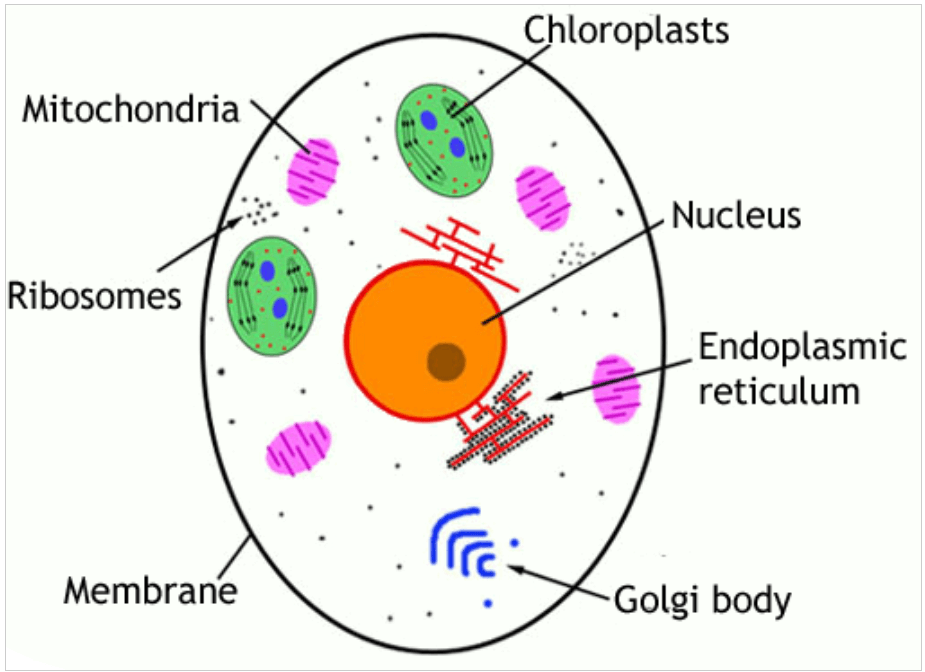
Structure of Cell
Cells have several structures that perform specific functions within them. The four main structures of a cell include the cell membrane, Cytoplasm, Nucleus, and Cell wall. These structures work together to maintain the cell’s integrity and carry out various biological processes essential for life.
| Different Structures of Cell | |
| Structures | Description |
| Cell Membrane | The cell membrane is the outermost boundary of the cell, separating it from its external environment. It regulates the passage of substances in and out of the cell. |
| Cytoplasm | The cytoplasm is a gel-like substance filling the cell and surrounding organelles. It contains various molecules, enzymes, and ions necessary for cellular processes. |
| Nucleus | The nucleus is the cell’s control center, housing genetic material (DNA) in the form of chromosomes. |
| Cell Wall | The cell wall is a rigid outer layer surrounding plant cells, providing structure and protection. It gives plants their shape and supports them, like a sturdy outer coat. |
Cell Membrane
The cell membrane, also called the plasma membrane, is like a protective skin around a cell. It’s a thin, flexible layer made of fats and proteins. Think of it as a gatekeeper: it controls what goes in and out of the cell. Nutrients can come in, and waste products can go out, all thanks to the cell membrane, keeping the cell safe and functioning properly.
Cell Wall
The cell wall is a strong, rigid layer that surrounds plants, algae, fungi, and some bacterial cells. It acts like a sturdy outer jacket, providing shape and support to the cell. Think of it as the cell’s armor. It’s made of cellulose and other materials, making the cell wall tough and protective. It helps plants stand upright and protects them from external pressures, giving the cell its structure and strength.
Nucleus
The nucleus is like the brain of a cell. It’s a round structure in the cell’s center, acting as a control center. Inside the nucleus are chromosomes, which carry the cell’s instructions to guide the cell’s growth, reproduction, and function. The nucleus is vital for the cell’s activities, ensuring everything works as it should and allowing the cell to function properly.
Cytoplasm
Cytoplasm is the jelly-like substance filling the inside of a cell. It’s like the cell’s soup, containing water, salts, and various molecules. Within the cytoplasm, important cellular processes occur, such as metabolism and protein synthesis. It provides a medium for organelles to float in, allowing them to interact and perform their functions. Cytoplasm is essential for the cell’s structure and supports various biochemical reactions necessary for life.
Cell Organelles
Cell Organelles are specialized structures within a cell that have specific functions and play crucial roles in the cell’s overall functioning. Each organelle has a specific job that helps the cell survive, grow, and reproduce. These organelles work together in a coordinated manner, allowing the cell to carry out various biological processes necessary for its survival and functioning. Some of the Cell organelles are:
- Mitochondria
- Endoplasmic Reticulum
- Golgi apparatus
- Ribosomes
- Lysosomes
- Vacuoles
- Chloroplast
- Cytoskeleton
- Centrioles
| Different Cell Organelles | |
| Organelles | Description |
| Mitochondria | Mitochondria are known as the powerhouse of the cell, producing energy (ATP) through cellular Respiration. |
| Endoplasmic Reticulum | Endoplasmic Reticulum is a network of membranes involved in protein and lipid synthesis. They are of two different types: Rough endoplasmic reticulum and Smooth endoplasmic reticulum. |
| Golgi Apparatus | Golgi apparatus modifies, sorts, and packages proteins and lipids for transportation. |
| Ribosomes | Ribosomes are the sites of protein synthesis, where amino acids are assembled into proteins. |
| Lysosomes | Lysosomes are vesicles containing enzymes that break down waste materials and cellular debris. |
| Vacuoles (in plant cell) | Vacuoles are membrane-bound sacs for storage, Digestion, and waste removal. |
| Chloroplast (in plant cell) | The chloroplast contains chlorophyll for Photosynthesis, enabling the plants to make their own food. |
| Cytoskeleton | The cytoskeleton is the network of protein filaments providing structural support and facilitating cellular movement. |
| Centrioles (in animal cells) | The centrioles play a role in organizing microtubules during cell division. |
Mitochondria
Mitochondria are tiny structures in cells, often called the “powerhouse” of the cell because they produce energy for the cell. They convert nutrients into energy in the form of a molecule called ATP, which cells use to carry out various functions. Think of mitochondria as cell batteries, providing the energy needed to keep the cell and the organism alive and functioning.
Endoplasmic Reticulum
The endoplasmic reticulum (ER) is a network of membranes inside cells, like a cellular highway system. The endoplasmic reticulum is of two types: the Rough endoplasmic reticulum and the Smooth endoplasmic reticulum. The rough endoplasmic reticulum consists of ribosomes and helps to make and transport proteins, while the smooth endoplasmic reticulum does not consist of any ribosomes and is involved in tasks like lipid (fat) synthesis and detoxification. Essentially, ER helps cells produce, process, and transport important molecules.

Golgi Apparatus
The Golgi apparatus is a cellular structure resembling a stack of flattened sacs. Think of it as a cell’s packaging and shipping center. It modifies, sorts, and packages proteins and other molecules made in the cell. These packaged products are then sent to various parts of the cell or outside of it, allowing the cell to function properly and communicate with other cells.
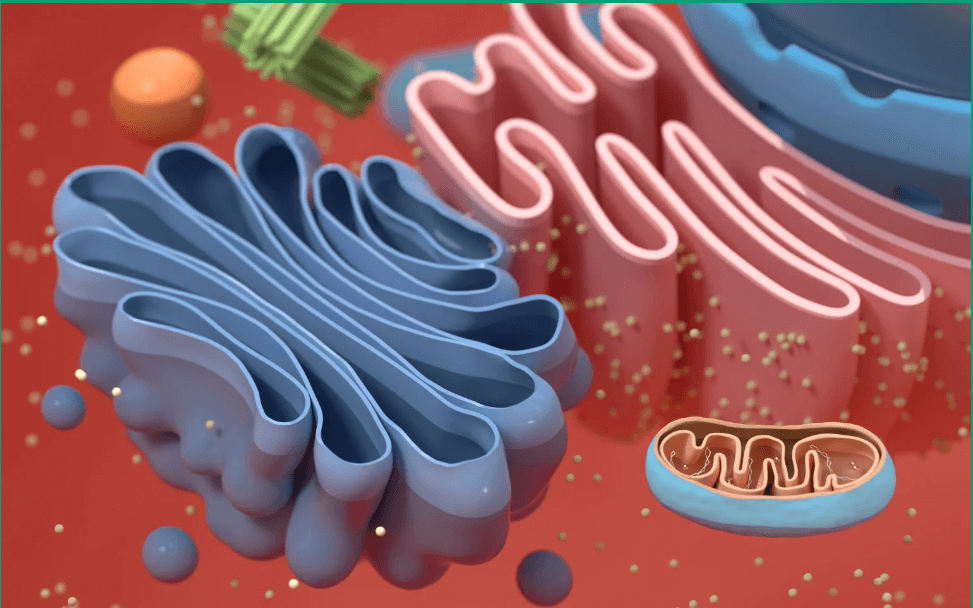
Ribosomes
Ribosomes are tiny structures that act like protein factories. Ribosomes are also known as the “Powerhouse” of the cell. They are found in both animal and plant cells. Ribosomes read the genetic information in messenger RNA and use that information to build proteins from amino acids. In simpler terms, they play a crucial role in making the proteins that cells need to function and grow.
Lysosomes
Lysosomes are special compartments in cells that work as recycling centers. They contain enzymes that break down waste materials, old cell parts, and foreign substances, turning them into reusable material. Essentially, lysosomes help cells clean up and maintain their internal environment, contributing to the cell’s overall health and proper functioning.
Vacuoles
Vacuoles are membrane-bound sacs found in the cells of plants, fungi, and some protists. They act like storage units, holding various substances such as nutrients, water, or waste products. In plant cells, vacuoles also provide structural support, maintaining cell shape and turgor pressure. Think of vacuoles as versatile containers that store essential materials and help maintain cell stability.
Chloroplasts
Chloroplast are green organelles found in plant cells and some algae. They are like tiny solar power plants, capturing sunlight through a pigment called chlorophyll. Through a process called photosynthesis, chloroplasts convert sunlight, carbon dioxide, and water into glucose (energy) and oxygen. This process fuels plant growth and provides oxygen for other living organisms, playing a crucial role in the Earth’s ecosystem.
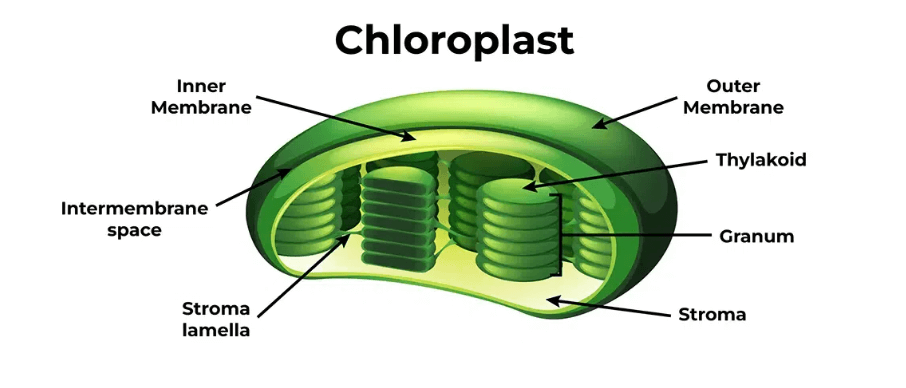
Types of Cells
A cell is of two main types: Prokaryotic cells and Eukaryotic cells, differing primarily in their structure and organization. Both prokaryotic and eukaryotic cells differ significantly in complexity and organization, reflecting the evolutionary diversity of life on Earth. These distinctions in the cellular structure are crucial as they define the basic differences between the two major categories of living cells.
| Different Types of Cells | |
| Types of Cells | Description |
| Prokaryotic Cells | Prokaryotic cells lack a nucleus and organelle, with genetic material concentrated in the nucleoid region. They are simpler than eukaryotic cells, found in bacteria and archaea. |
| Eukaryotic Cells | Eukaryotic cells have a defined nucleus enclosed in a membrane, along with various organelles. They are structurally complex and found in plants, animals, fungi, and protists. |
Prokaryotic Cells
- No Nucleus: Prokaryotic cells lack a defined nucleus. Instead, their genetic material is scattered throughout the cytoplasm in a region called the nucleoid.
- Simple Structure: They are generally smaller and similar in structure, lacking membrane-bound organelles.
- Cell Wall: Many prokaryotic cells have a rigid cell wall surrounding the cell membrane, providing structural support and protection.
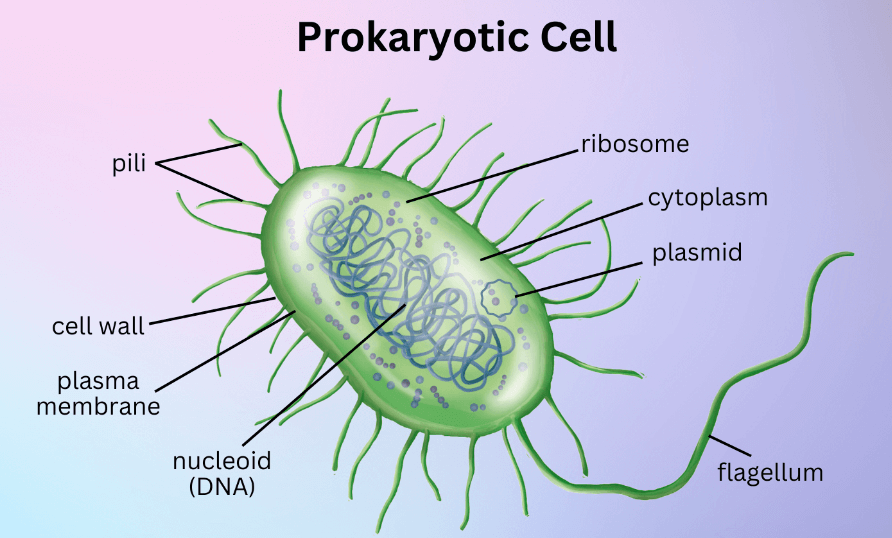
- Example Organisms: Bacteria and Archaea are examples of prokaryotic organisms.
- Bacteria: Prokaryotic cells are found in bacteria. They lack a true nucleus and membrane-bound organelles.
- Archaea: Another group of single-celled organisms with prokaryotic cells, similar to bacteria but with distinct genetic and biochemical differences.
Eukaryotic Cells
- Nucleus: Eukaryotic cells have a distinct nucleus enclosed within a double membrane, which houses the genetic material (DNA).
- Complex Structure: They are larger and more structurally complex than prokaryotic cells. Eukaryotic cells contain various membrane-bound organelles like mitochondria, endoplasmic reticulum, and Golgi apparatus.
- Cytoplasmic Streaming: Eukaryotic cells often exhibit cytoplasmic streaming, where organelles and other substances move within the cell’s cytoplasm.
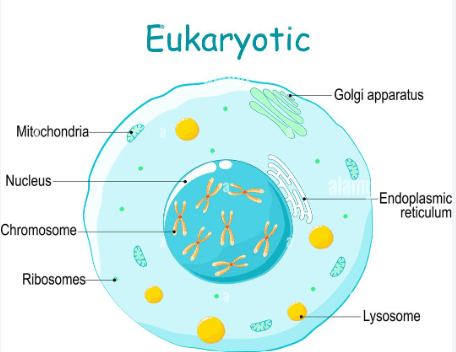
- Example Organisms: Animals, plants, fungi, and protists are examples of eukaryotic organisms.
- Animal Cell: Found in animals, eukaryotic animal cells have a true nucleus and various membrane-bound organelles like mitochondria and endoplasmic reticulum.
- Plant Cells: These cells make up plants and have additional structures like chloroplasts for photosynthesis and a rigid cell wall.
Functions of a Cell
Cells perform various functions essential for the survival of living organisms. Here we have discussed some of the key functions of a cell. These functions are carried out by various cell organelles and structures, each specialized for specific tasks within the cell.
- Energy Production: Cells generate energy through processes like cellular respiration (in mitochondria) or photosynthesis (in plant cells).
- Storage: Cells store nutrients, ions, and waste products. For example, plant cells store energy in the form of starch.
- Structural Support: Cells provide structural support to tissues and organs. Plant cells have a rigid cell wall for structural support.
- Transport: Cells transport molecules, such as nutrients and oxygen, across their membranes to maintain internal balance.
- Growth and Reproduction: Cells can grow in size and reproduce to create new cells through processes like mitosis and meiosis.
- Sensitivity: Cells can respond to various stimuli, allowing organisms to interact with their environment.
- Homeostasis: Cells help in maintaining a stable internal environment, ensuring balance and optimal conditions for cellular processes.
- Communication: Cells can communicate with each other through chemical signals, enabling coordination in multicellular organisms.
- Defense: Cells of the immune system defend the body against pathogens and foreign substances.



 50 Vegetables Name for Kids in English a...
50 Vegetables Name for Kids in English a...
 Food Chain: Definition, Types, Examples,...
Food Chain: Definition, Types, Examples,...
 Human Respiratory System: Definition, Di...
Human Respiratory System: Definition, Di...













